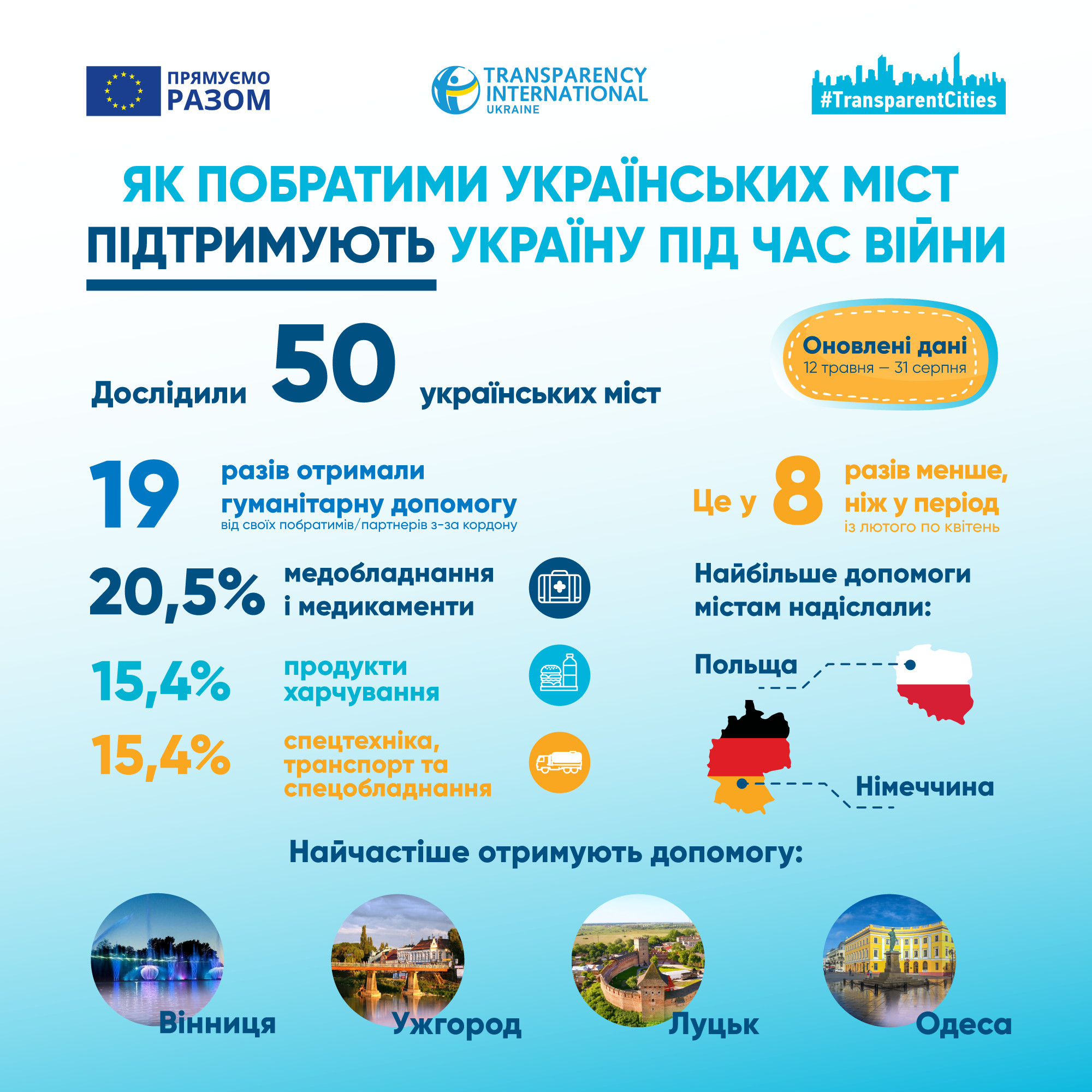During the 7 months of the large-scale war, the international community has been supporting Ukraine not only with military and technical equipment, but also with humanitarian aid. Partner cities and sister cities play a special role in this.
In May, the Transparent Cities program told how foreign municipalities helped Ukrainian cities that were ranked as first 50 in the Transparency Ranking of 2021. In a few months, we decided to go back to this topic and check out the changes that took place in the field of humanitarian assistance from the twin cities. And we came across some interesting conclusions!
Brief conclusions of the study:
- Foreign cities have provided humanitarian aid to their Ukrainian partners or sisters about 19 times during May-August. However, the aid has decreased by 8 times compared to February-April.
- The cities of Germany and Poland traditionally send the most aid — 9 and 8 times respectively. Countries of Transcaucasia (Azerbaijan) are among the countries whose cities send humanitarian cargoes.
The largest share of assistance is made up of medicines and medical equipment (20.5%), food (15.4%), as well as construction equipment, transport, and special equipment (15.4%).

The study found that sister cities have provided assistance to Ukrainian municipalities about 19 times between May 12 and August 31. The amount of assistance has decreased by 8 times compared to the previous study, and there is an explanation for this. Thus, during the 7 months of the war, Ukrainian cities have recovered from the shock and were able to set up management in wartime, including humanitarian and social processes. In addition, cities are now more acutely faced with the problem of preparing for the future heating season and rebuilding housing than food security.
The decline in the level of assistance was also influenced by the fact that more than 580 humanitarian organizations have provided vital assistance and services in the field of human protection. Therefore, Ukrainian cities have addressed less requests for humanitarian assistance to sister cities.
Germany (9 cases) and Poland (8 cases) have helped the most during the study period. They account for between 38% and 43% of all aid provided.
It is interesting that countries of Transcaucasia are among those countries whose cities send humanitarian cargoes. Thus, the city of Sumgait, which is located in Azerbaijan, has sent almost 50 tons of aid to Cherkasy.
Read more on the topic of twinning: how many sister cities have supported Ukrainian cities after February 24 and which Ukrainian cities have refused sisters from russia and belarus.
The German municipalities of Darmstadt and Regensburg helped their Ukrainian twin cities and partners twice between May 12 and August 31. It is indicative that these cities were also among the leaders in the previous study.
Vinnytsia (3 times), Uzhhorod (3 times), Lutsk (2 times), and Odesa (2 times) are Ukrainian cities that have received the most aid from abroad.
It is important that foreign cities that are not officially partners or sisters with Ukrainian municipalities also help with humanitarian aid. For example, 3 Polish cities (Dębica, Kraków, Auschwitz) that are having friendly relations with Zhytomyr, have helped it with medical and computer equipment, hygiene products, and children's clothes.
Studying sister cities: in which areas our cities cooperate with foreign partners, and how sister cities help Ukraine (part 1 and part 2).
Among the assistance provided, medicines and medical equipment, food, as well as construction equipment, and transport are predominant. It is interesting that more and more sister cities are helping to implement social initiatives. Thus, German, Lithuanian, and Polish municipalities have organized a holiday for schoolchildren from Novovolynsk. At the same time, Regensburg has helped with the evacuation of 50 residents of Odesa and provided them with housing, food, and treatment.
Useful information for cities
Having analyzed 50 Ukrainian cities, we should note that not all municipalities and not in all cases make the information about the types of assistance provided and its tonnage public. This is important, both for those cities that have already helped Ukraine, and for those who are just about to do so.
Tips for Ukrainian cities that will reduce corruption risks and form an image of responsible partners among sister cities can be found in our material.
Although the amount of assistance from sister cities and partners is declining, there are still municipalities, ready to address the humanitarian needs of our cities. Moreover, cooperation can also relate not only to the provision of goods, but also to services, such as evacuation or support for refugees.
We strongly recommend Ukrainian cities to expand their network of partnerships with cities abroad! Here are some tips from our team on how to do this.
How did we study it?
The study was conducted between September 2 and 8, 2022. Based on the analysis, we used data from open sources (official sites of city councils, Facebook pages, telegram channels of local self-government bodies, the mayor, or their deputies, the media) on humanitarian assistance from partners and sister citiess of the TOP 50 most transparent cities of Ukraine in the period from May 12 to August 31.
There are 20 oblast centers among the studied 50 cities, and the cities themselves represent all 24 oblasts of Ukraine. Volyn (Lutsk, Volodymyr, Novovolynsk), Dnipropetrovsk (Dnipro, Kamianske, Nikopol, Pokrov, Kryvyi Rih, Pavlohrad), Donetsk (Mariupol, Bakhmut, Pokrovsk, Kramatorsk), Ivano-Frankivsk (Ivano-Frankivsk, Kalush, Kolomyia), Lviv (Drohobych, Lviv, Chervonohrad), Khmelnytskyi (Khmelnytskyi, Dunaivtsi, Kamianets-Podilskyi, Netishyn) oblasts are represented the most in the study.
The material was prepared jointly with an intern of the Transparent Cities program Iryna Balakhovtseva.